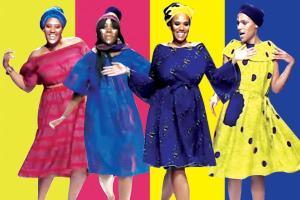The basic definition of beauty or acceptability is not about to be altered to include a profusion of ideas. Please stay in aukaat

Illustration/Ravi Jadhav
![]() Have you, like me, watched the viral video of the Afrodance group, Gold Caviar Crew, at the Vienna Fashion Show about 40 times last week?
Have you, like me, watched the viral video of the Afrodance group, Gold Caviar Crew, at the Vienna Fashion Show about 40 times last week?
ADVERTISEMENT
There they are, four Nigerian women, different shapes and sizes, dancing down a runway, mashing up different dance styles (shaku shaku, zanga, gwara gwara, says their Instagram post). Their dresses are casual and vivid, lime-green and purple, blue and gold, and swishy-swirly. But, the best part? They are barefoot and radiating maza. They stop as they pass each other, do small, co-ordinated moves together before dancing on with masti: it's playful, it's confident, it's mobile and tactile, it's bursting with appetite and presence. Watching it filled me with a sense of possibility, and for the rest of the day, I did everything in hip swirls and hopping dance moves, whether it was getting water from the fridge or answering the doorbell, as also following various African fashion Instagram accounts (do it). It was as if the runway chilled out.
And, god knows, runways need chilling out. I've never understood why models are supposed to look like they are either mean or in a bad mood. Their moves not saying 'wear this dress', but rather, 'please, don't get any ideas, okay?' The extension of this world is also strangely inert. Even fashionable women with excellent taste, like say, Sonam Kapoor, often wear couture with an air of being part of someone else's photograph: a woman in a dress rather than a dress on a woman. It's a cunning conformity through design.
A friend once bought me a sari from a designer whose Instagram spiel is all about 'real' women. He excitedly shared the picture of me in it with the designer ("I told him you wore it for your film premiere"), thinking he would share my photo, too, despite my laughing assurances it would never happen. Which it didn't.
That's partly because 'real' in fashion-speak means including atypical bodies, for diversity brownie points, in limited, appointed ways. Frida Kahlo bushy brows, Nicobar duskiness, fetching kajal and beard, a little voluptuousness: theek hai. But, let's not admit just anyone, baba. These patronising inclusions announce that the 'reals' are visitors in the palace of good looks. The basic definition of beauty or acceptability is not about to be altered to include a profusion of ideas. Please stay in aukaat.
That's fine. Our aukaat is pretty good. I love clothes. I've always been fat, and neither that, and nor the beady eye of fashion standardisation has come much in the way of me seeking out and wearing beautiful, flamboyant, expressive things. Not being a regular type is liberating, because you don't waste time fitting into a world not made for individuality, like a girl in mommy's sandals, but get on with the luxurious, adult business of discovering your taste and being yourself to the max.
Watching the women dance on the runway reminded me of that part of me. It reminded me of the many real women I see around me, at work, in trains, at parties and meetings, who have a cheeky, sexy, finger-licking, big appetite for life, and individual styles that runways are too narrow to contain. I'd say those dancers performed a token inclusion of the fashion world into the lively business of life, and for those minutes, allowed the runway to expand.
Paromita Vohra is an award-winning Mumbai-based filmmaker, writer and curator working with fiction and non-fiction. Reach her at www.parodevipictures.com
Catch up on all the latest Crime, National, International and Hatke news here. Also download the new mid-day Android and iOS apps to get latest updates
 Subscribe today by clicking the link and stay updated with the latest news!" Click here!
Subscribe today by clicking the link and stay updated with the latest news!" Click here!






